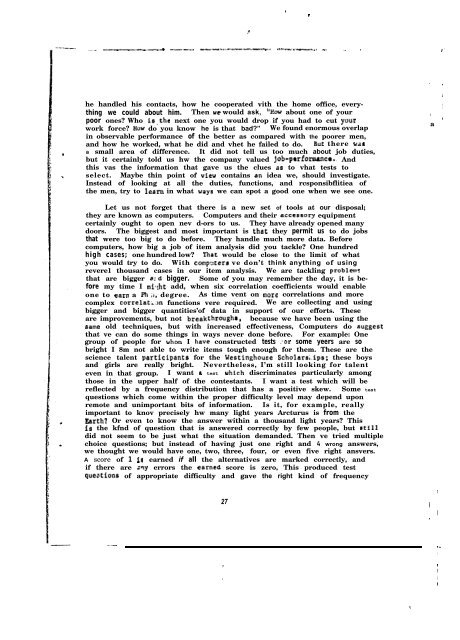Technical Report - International Military Testing Association
Technical Report - International Military Testing Association
Technical Report - International Military Testing Association
You also want an ePaper? Increase the reach of your titles
YUMPU automatically turns print PDFs into web optimized ePapers that Google loves.
.___ ---.-.-a ---._- ~.-~“..CI.~.--..w.‘r -.--.-.-^_. -. ._ .<br />
.’<br />
!<br />
)<br />
he handled his contacts, how he cooperated vith the home office, everything<br />
we could about him. Then WC would ask, “gow about one of your<br />
poor ones? Who is.the next one you would drop if you had to cut iour<br />
work force? Haw do you know he is that bad?” We found enormous overlap<br />
in observable performance of the better as compared with the poorer men,<br />
I<br />
a<br />
’<br />
and how he worked, what he did and vhet he failed to do. but there wds<br />
a small area of difference. It did not tell us too much about job duties,<br />
but it certainly told us hw the company valued job-parform=ca.. And<br />
this vas the information that gave us the clues 8S to vhat tests to<br />
select. Maybe thin point of view contains 8n idea we, should investigate.<br />
Instead of looking at all the duties, functions, and rcsponsibflitiea of<br />
the men, try to leern in what wrys we can spot a good one when we see one.<br />
Let us not forget that there is a new set of tools at our disposal;<br />
they are known as computers. Computers and their accessoF equipment<br />
certainly ought to open nev d-ors to us. They have already opened many<br />
doors. The biggest and most important is thet they permit us to do jobs<br />
that were too big to do before. They handle much more data. Before<br />
computers, how big a job of item analysis did you tackle? One hundred<br />
high cases; one hundred low? That would be close to the limit of what<br />
you would try to do. With comp::ters ve don’t think anything of using<br />
revere1 thousand cases in our item analysis. We are tackling problem?<br />
that are bigger erd bigger. Some of you may remember the day, it is before<br />
my time I mfl;ht add, when six correlation coefficients would enable<br />
one to e8rn a I% ;i. degree. As time vent on more correlations and more<br />
complex correlat;.)n functions vere required. We are collecting and using<br />
bigger and bigger quantities’of data in support of our efforts. These<br />
are improvements, but not breekthrougha, because we have been using the<br />
s8me old techniques, but with increased effectiveness, Computers do uuggest<br />
that ve can do some things in ways never done before. For example: One<br />
group of people for vhcxu I heve constructed tests .-or some yeers are so<br />
bright I 8m not able to write items tough enough for them. These are the<br />
science talent perticipants for the Westinghouee Scholare;.ips; these boys<br />
and girls are really bright. Nevertheless, I’m still looking for talent<br />
even in that group. I want a test vhich discriminates particularly among<br />
those in the upper half of the contestants. I want a test which will be<br />
reflected by a frequency distribution that has a positive skew. Some test<br />
questions which come within the proper difficulty level may depend upon<br />
remote and unimportant bits of information. Is it, for example, really<br />
important to knov precisely hw many light years Arcturus is from the<br />
Earth? Or even to know the answer within a thousand light years? This<br />
fs the kfnd of question that is answered correctly by few people, but etfll<br />
did not seem to be just what the situation demanded. Then ve tried multiple<br />
choice questions; but instead of having just one right and 4 wrong answers,<br />
we thought we would have one, two, three, four, or even five right ansvers.<br />
A score of 1 is earned if all the alternatives are marked correctly, and<br />
if there are ;qy errors the earned score is zero, This produced test<br />
questions of appropriate difficulty and gave the right kind of frequency<br />
.<br />
.<br />
27 i<br />
-._ ._<br />
,<br />
.<br />
, 3 t,<br />
^><br />
.<br />
. ,<br />
I<br />
i<br />
1<br />
I’<br />
I<br />
/









